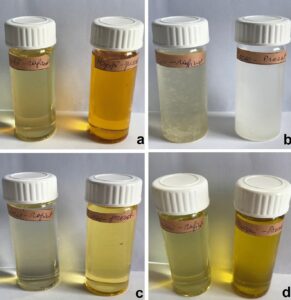The density of oil varies depending on the type and temperature, but typically ranges from 0.8-0.97 grams per cubic centimeter. Oil density is an important physical property used in the petroleum industry to determine its quality and value.
Density is defined as the mass of a substance per unit volume, and it is typically given in grams per cubic centimeter or pounds per gallon. The density of an oil varies depending on its composition, age, temperature, and pressure conditions.
Crude oil is usually less dense than water, but heavy crude oil may be denser than water. Moreover, oil density affects the performance of engines and machines, as well as the ease of transportation and refining. It is a crucial factor to consider in the exploration, extraction, production, and marketing of oil and gas resources.

Credit: wtfcannabis.io
Understanding The Importance Of Fluid Dynamics
Fluid dynamics is a crucial branch of physics that studies the movement of liquids and gases. It’s a vital concept that finds its application in various fields such as engineering, meteorology, oceanography, chemical processing, and many others. Fluid dynamics assumes significant importance in the world of oil and gas exploration, where a proper understanding of fluid behavior can lead to several breakthroughs.
One of the key properties that influence fluid dynamics is density.
Importance Of Fluid Dynamics In Various Fields
Fluid dynamics play a fundamental role in understanding the behavior of fluids in various fields. Here are some of the areas where it’s vital:
- Engineering: Fluid dynamics is often used in designing and testing aircraft, cars, ships, and other vehicles.
- Meteorology: Understanding fluid behavior is crucial for predicting weather patterns and forecasting natural calamities like hurricanes, monsoons, cyclones, etc.
- Oceanography: Fluid dynamics is used to monitor the movement of water, tides, and waves in oceans and seas.
- Chemical processing: The production of chemicals and drugs relies heavily on proper fluid dynamics.
- Oil and gas: Proper knowledge of fluid dynamics is crucial in the exploration and extraction of oil and gas.
Role Of Density In Fluid Dynamics
Density plays a significant role in fluid dynamics as it influences the movement of liquid or gas. Here are the key aspects:
- Density and viscosity: Viscosity is a fluid’s resistance to flow, and it’s directly proportional to its density. Higher density fluids tend to be more viscous than less dense fluids.
- Density and buoyancy: Objects float or sink in fluids based on the balance of their weight and buoyancy. If an object is denser than the fluid it’s in, it sinks, and if it’s less, it floats.
- Density gradients: Fluids with varying densities can create density gradients, where lighter fluids rise above denser fluids. These gradients can play a vital role in ocean circulation and stratification.
Understanding the importance of fluid dynamics and density is crucial in various industries. It helps us predict, control, and utilize fluid movements efficiently. As we continue to evolve and face new challenges, the importance of fluid dynamics is only set to increase further.
Defining Density And Its Application To Oil
Oil exploration is an essential part of the global economy. To optimally extract it, understanding density is critical. Density calculations and measurements are essential in determining how much oil a particular reservoir contains. Density also plays a vital role in the overall exploration process.
In this section, we will define density and explore its application in oil exploration.
What Is Density?
Density is a measurement of how much mass an object or substance has per unit of volume. In simple terms, it is the amount of matter in a given space. Density is calculated by dividing the mass of an object by its volume.
How Is Density Measured?
There are different methods of measuring the density of oil. These include:
- Api gravity: Api (american petroleum institute) gravity is a standard measure used to determine the density of crude oil relative to water. Api gravity increases as the density decreases. It is measured in degrees.
- Hydrometer: A hydrometer is a device used to measure the density of liquids. It works by measuring the buoyancy of the fluid. The hydrometer measures the difference between the weight of the liquid and the weight of the same volume of water.
- Pycnometer: A pycnometer is a container used to measure the density of a liquid. The container is weighed before and after it is filled with the liquid under test. The density of the liquid is then calculated using the mass and volume of the liquid.
The Role Of Density In Oil Exploration
Density is crucial in oil exploration and production. Here are some of the ways density is applied in oil exploration:
- Estimating the amount of oil in a reservoir: Measuring the density of the underground rock formation can give geologists an idea of its porosity and permeability. This information can help estimate the amount of oil a reservoir contains.
- Separation of oil and water: Knowing the density of crude oil enables engineers to separate it from water. This process is critical in the production of crude oil.
- Designing oil rigs: Knowledge of the density of crude oil is vital in designing oil rigs. The weight and strength of the structure need to be able to support the weight and density of the oil being extracted.
Density is a critical factor in oil exploration, allowing geologists and engineers to estimate the amount of oil in a reservoir, separate oil from water, and design appropriate structures for oil rigging. By understanding the significance of density in oil exploration, we can better appreciate the complexity of the process and the effort required to extract oil sustainably.
Understanding The Composition Of Oil
Composition Of Crude Oil
Crude oil is a complex mixture of hydrocarbons that come from decaying organic matter. Its composition can vary based on the location it was extracted from and its age. The main components of crude oil are carbon and hydrogen, but it also contains small amounts of sulfur, oxygen, nitrogen, and metals.
Some of the types of hydrocarbons found in crude oil are:
- Alkanes: These are straight or branched hydrocarbons with single bonds between carbon atoms.
- Alkenes: These hydrocarbons are unsaturated and have a double bond between carbon atoms.
- Aromatics: These hydrocarbons have ring structures and contain alternating double bonds.
Variations In Oil Density Based On Composition
The density of crude oil can vary based on its composition. Generally, the lighter the crude oil, the less dense it is. Light crude oil has a low viscosity and flows more freely because it contains a higher amount of smaller hydrocarbon molecules.
Heavy crude oil, on the other hand, has a higher density and viscosity because it contains more complex and larger hydrocarbons.
The american petroleum institute (api) gravity scale is used to measure the density of crude oil. The higher the api gravity, the lighter the crude oil. Light crude oil typically has an api gravity of 40 or higher, while heavy crude oil has an api gravity of 20 or less.
How Density Affects Oil Production
The density of crude oil affects oil production in several ways. It affects:
- Extraction: Heavy crude oil is more difficult to extract and requires more energy for drilling and pumping.
- Refining: Refineries can process a limited amount of heavy crude oil, as it requires more processing to remove impurities.
- Transportation: Heavy crude oil is more challenging to transport as it needs to be heated or diluted for it to flow through pipelines.
The density of crude oil also affects the returns from oil production. Generally, the lighter the crude oil, the higher the price it commands in the market due to its lower processing costs and higher yields of petroleum products.
Understanding the composition of oil is essential to comprehend its density and its impact on oil production, extraction, refining, and transportation. Knowing these factors can help oil companies make informed decisions about what type of crude oil to produce and how best to extract it.
The Significance Of Density In The Oil Industry
The oil industry is essential to various economies across the globe. Several factors affect oil production and flow, and one significant criterion is the density of oil. Density refers to the amount of mass contained in a given volume. In the oil industry, this factor plays a vital role in determining oil production, flow, and reserves.
In this section, we’ll explore the importance of density in oil drilling, the effects of density on oil flow, and the link between density and oil reserves.
Importance Of Density In Oil Drilling
Oil drilling involves several complex processes that require precise measurements. Density is one such measurement that holds great significance in the drilling process. Here are some essential points to consider:
- Density of drilling mud is crucial to maintain hydrostatic pressure to prevent the influx of formation fluids.
- A high-density drilling mud enables the suspension of drill cuttings, preventing them from settling at the bottom of the wellbore.
- Density also plays a vital role in supporting the weight of the drilling tools and pipes.
Effects Of Density On Oil Flow
The density of oil is a crucial factor in determining the flow rate of oil through pipelines. Here are some essential points to consider:
- High-density crude oil flows slower than low-density oil.
- The density of crude oil changes with temperature. Higher temperatures cause the oil’s density to decrease, leading to faster flow rates.
- When two different grades of crude oil are mixed, the resulting density affects the flow rate through the pipeline.
The Link Between Density And Oil Reserves
Density is a critical factor in determining oil reserves. The density of crude oil affects the volume of oil produced and the amount of oil that can be extracted. Here are some essential points to consider:
- Oil companies use the density of crude oil to estimate the probable reserves in a particular region.
- Dense oil formations have a higher volume of oil reserves because the oil is trapped in small pores and cracks in the rock.
- The measured density of oil helps determine the production rate and the amount of oil that can be extracted cost-effectively.
The density of oil plays a vital role in the oil industry. It affects oil production, flow, and estimates of oil reserves. Understanding the significance of density is essential for successful oil drilling and refinery operations.
Fluid Dynamics In Oil Reservoirs
Oil reservoirs are intricate networks of rock and fluid systems. The production of oil from such formations demands a comprehensive understanding of various aspects of fluid dynamics. Here is a rundown on the role of fluid dynamics in oil exploration and recovery processes.
Fluid Properties And Flow Behavior In Oil Reservoirs
Oil reservoir fluid properties refer to their unique physical and chemical characteristics that define their behavior. Here are some facts regarding the same:
- The fluid in oil reservoirs is a combination of oil, gas, and water, and each has different densities, viscosities, and chemical properties.
- These properties can change under different temperatures, pressures, and geological conditions.
- Understanding fluid behavior is critical in predicting how fluids will move through the reservoir upon recovery, which helps in selecting the production techniques.
The Role Of Fluid Dynamics In Oil Exploration And Recovery
Fluid dynamics in oil reservoirs are crucial for oil production since it plays a significant role in reservoir management, recovery efficiency, and overall operations. Here are some points highlighting the importance of fluid dynamics:
- Fluid dynamics can help augur the behavior of fluids in a reservoir, which is vital in determining the best recovery method, and how much oil can be recovered.
- Understanding fluid dynamics can help reduce oil recovery costs, increase efficiency, and optimize the recovery process.
- Fluid dynamics can also help in identifying and mitigating risks related to fluid flow behavior in the reservoir.
Analyzing Pressure And Flow Rate Using Fluid Dynamics
Fluid dynamics also plays a crucial role in analyzing pressure and flow rates within oil reservoirs. Here are some points about the same:
- Fluid dynamics provides various techniques for measuring the pressure at different points in the reservoir, which is crucial in determining the state of the fluids within the reservoir.
- Flow rate analysis helps in calculating the quantity of fluids that move through any point in the reservoir over a specific period.
- Analyzing pressure and flow rates also help estimate the reservoir’s productivity potential, which informs operational and investment decisions.
A proper understanding of fluid dynamics is absolutely crucial in the oil exploration and recovery process. It’s essential for optimizing oil recovery, reducing costs, and ensuring operational efficiency.
Analyzing Fluid Dynamics In Oil Pipes And Tanks
Fluid Dynamics In Pipes And Tanks
Oil is transported through pipelines and stored in tanks through fluid dynamics. Fluid dynamics is the study of how fluids behave in motion. It plays a critical role in the oil industry because it determines the efficiency and safety of transportation and storage systems.
Here are the key points to consider when analyzing fluid dynamics in pipes and tanks:
- Oil behaves like a viscous liquid that follows the laws of bernoulli’s principle, which states that as fluid speed increases, its pressure decreases. As a result, oil flows faster through narrow pipelines and slower in wider ones.
- Oil is sensitive to temperature changes. As oil warms up, it expands and vice versa. Therefore, it’s crucial to maintain the right temperature in pipelines and tanks to ensure the oil doesn’t lose or gain any volume, which can result in costly errors.
- The viscosity of oil, which is its resistance to flow, determines its flow rate. The higher the oil’s viscosity, the lower its flow rate. This factor is crucial in determining the type of pipeline or tank that’s appropriate for a particular oil type.
The Importance Of Density In Pipeline Transportation
Density is a crucial factor to consider when transporting oil through pipelines. Density measures the amount of mass per unit volume of a substance. Density is critical in pipeline transportation due to the following reasons:
- Density determines the type of pipeline that’s appropriate for specific oil types. Heavy crude oil has high density, and it’s transported in pipelines that are designed for high-pressure operations. Light crude oils have lower density, and they’re transported in pipelines with lower pressure ratings.
- Density determines the amount of oil that can be transported through a pipeline. The higher the oil’s density, the lower its flow rate and vice versa. Therefore, it’s important to measure the density of the oil before transportation to determine the amount of oil that can be transported through a pipeline.
Understanding How Fluid Dynamics Affect Oil Storage
Fluid dynamics affects the efficiency and safety of oil storage systems. Here are the key points to consider when analyzing fluid dynamics in oil storage:
- The shape and size of the tank determine the efficiency and safety of the storage system. The shape of the tank affects the flow rate of the oil. The larger the tank, the slower the oil will flow, which can lead to settling or sedimentation, which reduces the purity of the oil.
- Temperature affects the density of oil, which, in turn, affects its flow rate and settling. Therefore, it’s important to maintain the right temperature in oil tanks.
- The level of oil in a tank also affects its flow rate. As the level decreases, the flow rate decreases. Therefore, it’s essential to keep tanks filled to maintain a consistent flow rate.
Fluid dynamics is a crucial factor to consider when transporting and storing oil. The study of fluid dynamics helps us understand how different oil types behave in motion, the importance of density in pipeline transportation, and how fluid dynamics affect oil storage.
By applying these principles, we can create efficient and safe oil transportation and storage systems.
Understanding Gravity And Density
When discussing the properties of oil, density is an essential factor to understand. Density is the measurement of how much mass is in a given volume, and it is affected by many factors, including temperature, pressure, and gravity. In this section, we will concentrate on gravity and its effects on oil density.
How Gravity Affects Oil Density
Gravity plays a critical role in determining the density of oil. The force of gravity pulls mass towards the center of the earth, and the amount of force experienced depends on the distance from the earth’s center. This force causes denser materials to sink and less dense materials to rise.
For instance, crude oil is less dense than seawater, and this allows it to float on top of the water. The density of oil will change depending on the temperatures, pressures, and other factors surrounding it.
The Role Of Gravity In Density Measurement
Gravity’s effects are critical when measuring the density of oil. Density measurement requires that the test sample be at a specific temperature, pressure, and gravity level to produce accurate results.
Gravity plays a role in creating the pressure of the sample, and a change in gravity can cause significant changes in the pressure and subsequent density measurements. Variation in gravity can also cause small bubbles to form in the sample, which can affect the accuracy of the density measurements.
Techniques Used To Analyze The Density Of Oil
There are two primary methods used to analyze the density of oil, namely hydrometer method and digital density meters.
The hydrometer method is a manual approach that involves measuring the density of oil using a hydrometer. An operator immerses the hydrometer into the oil, and the hydrometer sinks to a particular depth, giving a corresponding density reading.
Digital density meters, on the other hand, use technology to measure a sample’s density. These instruments automatically measure the volume and mass of the oil sample to determine its density accurately.
Density and gravity work together to affect the properties of oil. As a result, measuring the density of oil requires careful consideration of the effects of gravity. Both manual and automated techniques are used to measure oil density accurately.
Measuring Oil Density In The Field
The density of oil plays a vital role in the oil and gas industry. It determines the quality of crude oil, helps in optimizing the production process, and facilitates transportation. Measuring oil density in the field requires accurate techniques and devices.
In this section, we discuss the different methods and instruments used to measure oil density in the field.
Devices Used To Measure Oil Density
There are various devices used to measure oil density in the field. The most commonly used instruments are:
- Hydrometers: They measure the density of a liquid by floatation. A hydrometer has a glass bulb and a graduated stem.
- Coriolis meters: They measure the mass flow rate of the fluid by measuring the induced coriolis effect.
- Digital density meters: They determine the density of a fluid by oscillating a u-tube inserting into the fluid.
- Nuclear density meters: They use gamma rays to measure the density of a fluid.
- Vibrating tube densimeters: They measure the density of the fluid by detecting changes in the frequency of the vibrating tube.
Understanding The Importance Of Accurate Density Measurement
The accurate measurement of oil density is crucial in the oil and gas industry. The reasons for this includes:
- Determination of the quality of crude oil: The density of crude oil can indicate its composition, which helps in identifying its suitability for specific purposes.
- Optimization of the production process: Accurate density measurement helps in determining the amount of oil that can be produced from a reservoir.
- Facilitation of oil transportation: The correct determination of oil density is required for pipelines and tankers’ capacity calculation.
Techniques For Calculating Oil Density In The Field
Accurate oil density measurement can be acquired through different techniques:
- Pycnometers: It measures the volume of oil using the displacement method and then calculates its density.
- Hydrometers: Using these is simple and cost-effective, although they are fragile and inaccurate.
- Digital density meters: They provide accurate and reliable measurements and are commonly used in modern oilfields.
- Nuclear magnetic resonance (nmr): This is a non-destructive technique used in the laboratory.
- Infrared (ir) spectroscopy: This sophisticated technique is for analyzing the unique spectra of crude oil samples.
Precise measurement of oil density is essential for efficient oil production, transportation, and processing. Using appropriate devices, understanding the importance of accuracy, and applying the correct measuring techniques, oil and gas industry personnel can ensure optimal operations while minimizing environmental risks.
Emerging Technologies For Measuring Oil Density
The oil industry has been a critical player in the world economy for over a century. Oil is a highly valuable commodity used in the production of fuel, plastics, and countless other products, which makes it vital to measure its density accurately.
The density of oil refers to how much it weighs per unit of volume and is crucial for determining the quality and value of crude oil. Over the years, technology has significantly evolved in the measurement of oil density.
New Technologies For Density Measurement
Recent advancements in technology have led to the development of new instruments that can measure density accurately and efficiently. Some of the recent technologies are:
- Density meters: They are designed to measure liquids of varying densities and do so by determining the frequency at which a vibrating tube is resonating, based on its weight. The technology incorporated in these meters can measure with high precision and accuracy.
- High-precision hydrometers: These are instruments that can measure the density of liquids, in this case, oil. They work by analyzing the fluid’s buoyant force measure, which is dependent on the fluid’s density and volume.
- X-ray fluorescence technology: The x-ray fluorescence analyzer can measure the density and quantity of the constituent elements of a material. This enhanced technology has been applied in the measurement of oil density, which has proven to be reliable and precise.
Advancements In Fluid Dynamics Research
To measure the density of oil, researchers have also looked into the fluid dynamics of oil and how it interacts with other fluids. One of the advancements is in the understanding of how the density of oil is affected by temperature and pressure.
There has been extensive research in the specific heat capacity of oil, which is critical in determining density.
New research led to the development of computational models, which can accurately predict the density of oil at specific temperatures and pressures. This advancement has immensely contributed to the accurate measurement of the density of oil, even under extreme temperatures and pressures.
The Impact Of New Technologies On The Oil Industry
The use of emerging technologies in oil density measurement has brought many benefits to the industry, including:
- Improved accuracy: The oil industry has strongly relied on errors-prone methods of measuring oil density, hence the need for accurate and precise instrumental tools. The use of these innovative technologies now guarantees results that are far more accurate.
- Efficiency: New technologies in the measurement of oil density have reduced both time and cost. An example of this is density meters, which have replaced the traditional methods of measuring density, such as the measurement of oil volume by weight.
- Achieving compliance: Oil density is a crucial element in determining quality and value, which directly affects the compliance standards of the industry regulations. The emergence of new technologies has also brought an improvement in compliance with international standards.
The measurement of oil density is critical in the oil industry since it plays a significant role in oil quality control, the pricing of crude oil, and complying with international standards. The constant efforts in emerging technologies have proven to be reliable, efficient, and accurate in the density measurement process.
Frequently Asked Questions On Density Of Oil
What Is The Density Of Oil?
The density of oil varies depending on the type. It typically ranges from 0. 8 to 0. 97 g/cm³.
How Is The Density Of Oil Measured?
The density of oil is measured using a device called a hydrometer. It determines the oil’s specific gravity, which is converted to density.
What Affects The Density Of Oil?
The density of oil is affected by its chemical composition, temperature, and pressure. For example, heavy crude oil has a higher density than light crude.
Is Density Important In Oil Production?
Density is important in oil production because it helps identify the type of oil and determine how it will behave during transportation and processing.
How Does Oil Density Impact The Environment?
The density of oil can impact its behavior in the environment. For example, dense oil may sink and be more difficult to clean up in the event of an oil spill.
Conclusion
The density of oil is an important characteristic that has a significant impact on various industries such as petroleum, chemical and manufacturing. Understanding the density of different types of oil helps us to determine their quality, composition, and suitability for specific applications.
It also plays a crucial role in the transportation and storage of oil, as different densities can affect the volume, weight, and flow of the oil. Overall, the density of oil is a complex topic that requires careful consideration and analysis.
As the demand for oil continues to rise, it is essential to continue researching and developing new technologies to improve our understanding and handling of this valuable resource. By leveraging the power of modern science and engineering, we can ensure a more sustainable and efficient future for our planet and its inhabitants.








